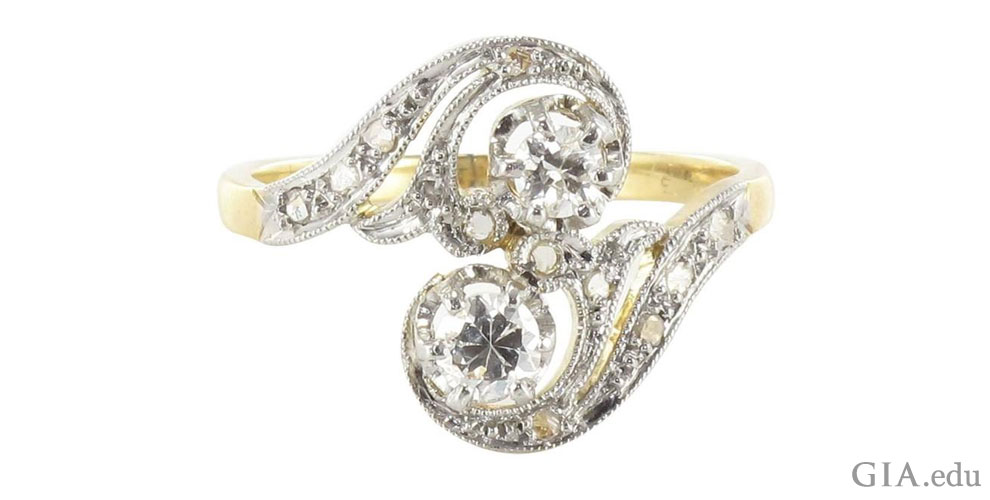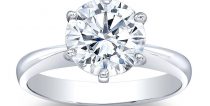Art Nouveau engagement rings are exquisitely beautiful, but rare. You can achieve the romance of Art Nouveau style in your own ring by using design elements from the period, like the whiplash line, enamel and colored gems. Here’s how.
Jewelry designers from the Art Nouveau era, which began in the 1890s and lasted into the early 1910s, drew on a diverse set of influences. Fascination with the natural world and a desire to break with the rigid design aesthetic of the Victorian era fired the imagination. After centuries of self-imposed isolation, Japan resumed trade with the west in the mid-1800s, and the art and art exhibits that followed also inspired designers of the day. Art Nouveau jewelry designers borrowed elements of Japanese art, like asymmetry (a lack of proportion between two parts of an object) and the economy of line (the elimination of non-essential elements) in their interpretation of nature, and created something entirely new.
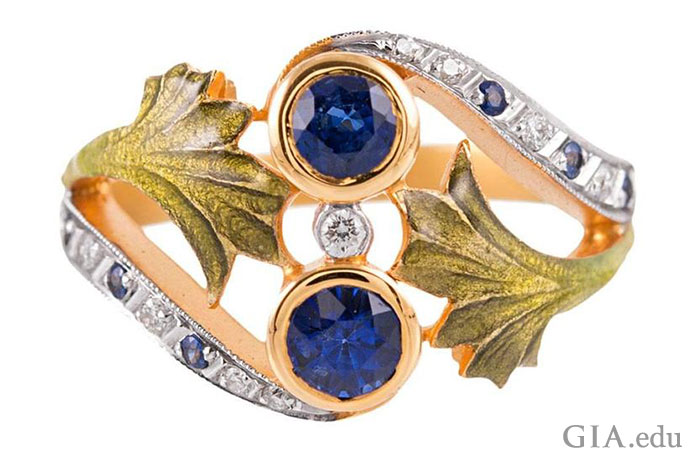
The unmistakable style of Art Nouveau blossoms in this contemporary ring and offers design elements that could be borrowed to create a unique engagement ring. Enameled leaves accent the two center sapphires, weighing a total of 0.80 carats. Sapphire and diamond melee glitters in the band. Courtesy: 1stdibs.com
Art Nouveau Style: The Whiplash Line
Free-flowing lines were the signature motif of the Art Nouveau era. One variation of this, the whiplash line, is a sinuous, asymmetrical line that resembles a cracking whip, the whiplash line evoked movement, dynamism, grace and power. Adding intertwining lines to ring designs can symbolize the joining of two lives and is sure to give Art Nouveau style engagement rings an authentic period feel.

René Lalique was one of the great designers of the Art Nouveau era. A number of period elements can be seen in this piece: whiplash lines, a motif from the natural world (two peacocks), the use of cloisonné enameling and unusual gems like opal and pearl. Courtesy: The Metropolitan Museum of Art, New York. Gift of Clare Le Corbeiller, 1991
Art Nouveau Style: The Use of Enamel
Enamel helped designers create the magical, dreamy look of Art Nouveau jewelry, and the technique made its way into Art Nouveau engagement rings. Enameling involves fusing glass onto a metal substrate (supporting material), and dates back to 1400 BCE. Period designers used several enameling techniques:

This striking bracelet may be modern, but its rich purple basse-taille enamel adorned with yellow gold cherries evokes the Art Nouveau era. Photo: Eric Welch/GIA. Courtesy: Mark Maxwell
- Cloisonné – Creating small cells, or cloisons, with wire on a metal background; then filling each cell with a certain color of powdered enamel and firing the piece.
- Champlevé – Digging cells or lines into metal, placing powdered enamel into the depressions and then firing the piece.
- Basse-taille – Engraving or carving metal to varying depths of low relief (basse-taille is French for “low cut”) and then covering it with transparent enamel, so the light imbues the colors with different tones after the piece is fired.
- Plique-à-jour – Making enamel look like stained glass by adding enamel powder to a cell backed by a sheet of copper foil or a similar metal, which is then fired. The sheet is removed with a light tap or acid, so the enamel that remains is unbacked and has the transparency of a pane of glass.
Enamel can chip, so you’d have to use it judiciously in an engagement ring. Make sure it is well protected by the mounting, preferably located in recessed areas. When cleaning Art Nouveau engagement rings that contain enamel work, use a damp cloth and rub gently.
Jewelry with enameling can be quite spectacular. Learn more about jewelry enameling techniques.

In this ring by René Lalique, circa 1900, two enameled poppies soothe the eye. The baroque freshwater pearl nestled between them is a delicate complement. Courtesy: 1stdibs.com
Art Nouveau Style: Celebrating Nature
The natural world enchanted Art Nouveau jewelry designers. Peacocks, swans, swallows, bats, dragonflies and butterflies were rich sources of inspiration. Designers often reimagined them as fantastical, sensuous creatures. Exotic flowers and twisting vines were also favorite subjects. You can use these motifs to recreate your own Art Nouveau engagement ring.

Pink, blue and lavender morning glories are featured in this gold and plique-à-jour enameled corsage ornament, circa 1900. Nature is beautifully depicted in this symbolic piece. Photo: Judy Colbert/GIA
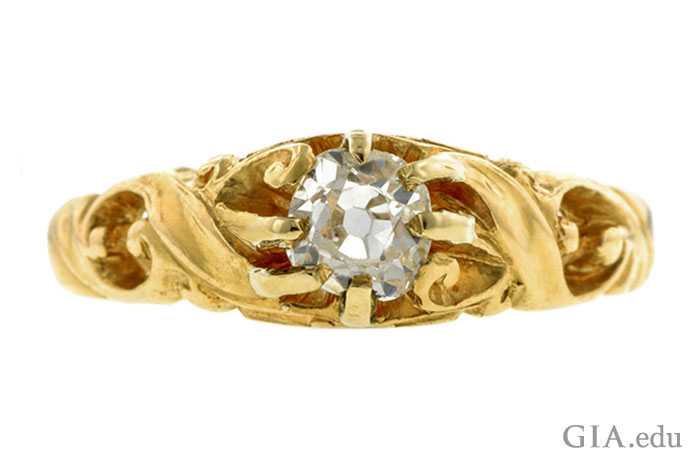
This gold Art Nouveau ring, circa 1900, is set with an old mine cut diamond that weighs 0.48 carat (ct). Curving, intertwined lines create a design that resembles vines or branches. Courtesy: Doyle & Doyle.

Like comets with long tails, the two main diamonds (a total of 0.36 carats) in this Art Nouveau style ring are trailed by curving diamond-studded lines that swirl throughout the ring. Courtesy: 1stdibs.com
Art Nouveau Style: Pearls
It’s no surprise that jewelry designers of the period, who were so fascinated by nature and its organic forms, would be drawn to organic gems like pearls. These gems from Earth’s lakes, rivers and seas were often used in Art Nouveau pendants and brooches, as well as in engagement rings of the period.
Pearls are soft gems, ranking 2.5–4 on the Mohs scale of mineral hardness. Easily scratched, pearls require special care. So they may not be good candidates for a modern engagement ring destined to see a lifetime of daily wear. You may want to consider incorporating this lovely gem into an Art Nouveau style pendant or earrings to complement your engagement ring.
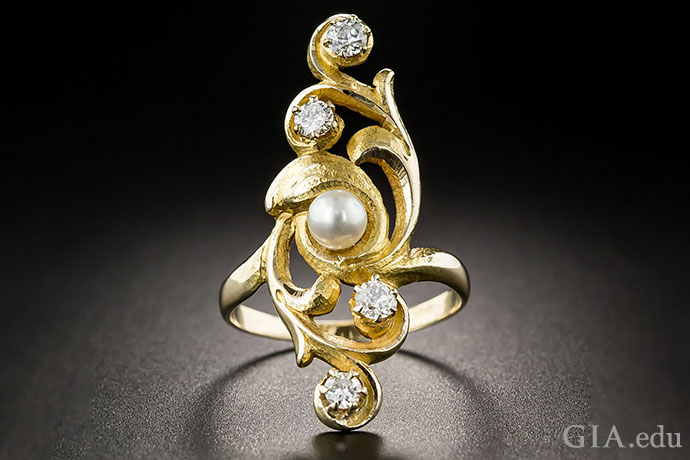
The pearl in this vintage Art Nouveau cocktail ring is like the calm eye of a storm, with a hurricane of curved lines swirling around it. Four diamonds shine like stars in the night sky. Courtesy: LangAntiques.com
Art Nouveau Style: Unusual Colored Gemstones
Art Nouveau jewelry designers had a gemological vocabulary they used to create pieces that were ethereal celebrations of nature. Some of their favorite materials included gems that evoked the sky, sea and other natural phenomena. Among these were moonstone, lapis lazuli and opal.
A word of warning, though, before choosing one of these gems for your Art Nouveau style engagement ring: While beautiful, they are not the most durable. So consider your lifestyle before selecting them for daily wear.
- Moonstone is a gem that charmed Art Nouveau designers. Light appears to billow across its surface, like the moon peeking out behind the clouds. This phenomenon is called adularescence.
- A gem variety of orthoclase feldspar, moonstone occurs in many colors. Although it is often white or gray, it can be blue, green, pink, yellow to brown, or nearly black. Most coveted is moonstone that is colorless and semitransparent to nearly transparent without visible inclusions, but with a vivid blue adularescence.
- Moonstone is a 6.0 to 6.5 on the Mohs scale of mineral hardness. If it hits a hard surface, it might chip or cleave; it also can be scratched and reacts to acid.

This vintage Art Nouveau-style ring conjures a celestial scene: A pale moonstone is orbited by eight diamonds. Courtesy: LangAntiques.com

A moonstone is the centerpiece in this modern ring, which was inspired by the Art Nouveau era. Courtesy: MetamorphosisJewelry.com
- Lapis lazuli was another favorite of Art Nouveau jewelry designers. A rock composed primarily of lazurite, calcite and pyrite, the preferred color is a uniform dark blue to violetish blue, without any visible calcite. Flecks of gold-colored pyrite throughout a stone can make it look like the star-studded Milky Way, and perhaps associations like this spoke to period designers.
- Depending on the mix of minerals, lapis lazuli’s hardness ranges from 5 to 6 on the Mohs hardness scale, making it a delicate gem. Some stones are dyed, and these may fade over time or the color may be removed if the stone is rubbed with acetone or another solvent. Some lapis lazuli has been coated with wax or plastic to enhance the polish or seal the dye; these coatings may deteriorate with wear, or when exposed to heat or solvents.

The lapis lazuli in this Art Nouveau ring (circa 1905) is carved in the form of a scarab – a symbol of life and rebirth in ancient Egypt, and a common motif of the Art Nouveau era. Fluted lines in the band that twist and turn resemble tree branches, evoking the natural world. Courtesy: Doyle & Doyle, www.doyledoyle.com

Art Nouveau lives in this contemporary ring. Lapis lazuli is the center stone, while sinuous whiplash lines slither around it. Courtesy: MetamorphosisJewelry.com
- Opal is famous for its play-of-color. To Art Nouveau jewelry designers, its changing colors suggested that it had an inner life. Famed French designer René Lalique used opal as a symbol of water or to mimic the eyes in a peacock’s tail.
- Opal is 5.0 to 6.5 on the Mohs hardness scale. It’s softer than many other gemstones, so it should be worn and stored carefully to prevent scratching. With a toughness that is very poor to fair, it is also vulnerable to breakage if hit. Opals should not be exposed to acids or caustic alkalis. They are generally stable to light, but heat from intense light or storage in airtight containers like safe deposit boxes can lead to dehydration that may cause the opal to crack or craze.
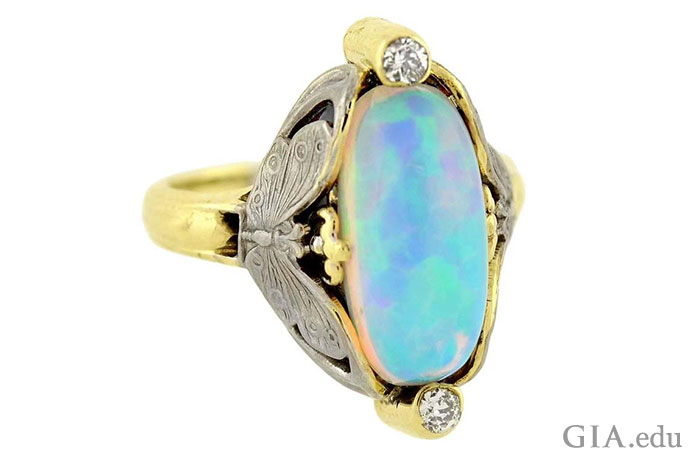
The opal in this vintage Art Nouveau ring (circa 1910) displays play-of-color in hues favored by jewelry designers of the era. Two white gold butterflies alight on the band. Diamond melee punctuate the top and bottom of the center stone. Courtesy: 1stdibs.com
If you’re looking to incorporate a colored gemstone in your Art Nouveau engagement ring design, think pastel colors in cool hues, like blue, green, orchid, and violet. And while moonstone, lapis lazuli and opal may not be suitable for modern-day Art Nouveau engagement rings, you can still replicate the Art Nouveau style by selecting a gem durable enough to withstand daily wear, like a sapphire, spinel, aquamarine or tourmaline.
It’s easy to fall in love with Art Nouveau jewelry, and want to get the style of Art Nouveau engagement rings. If you’d like to create your own, our Guide to Custom Made Engagement Rings is a great place to begin.

